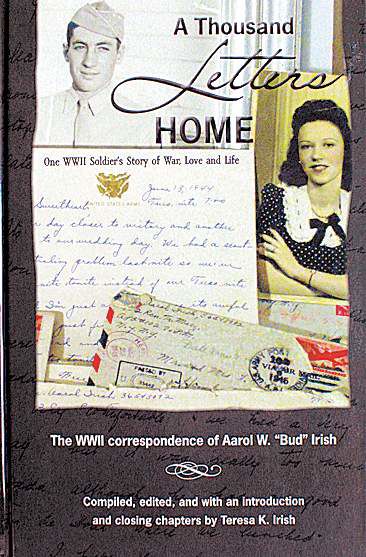War correspondence has changed
Published 4:00 am Tuesday, January 31, 2012

- The letters Bud Irish wrote his future wife and family members from World War II have been published in the new book “A Thousand Letters Home.” Visit the publication's website, www.athousandlettershome.com, for more information.
Chris Wulf and Elaine Irish share a common experience, even through they differ in age by almost 50 years.
Both women were separated from someone they loved as he was at war overseas, and they needed a way to stay in touch.
Before they were married in 1946, Elaine and Aarol “Bud” Irish spent 36 months apart while he served in American training camps and on the German front lines during World War II. The couple kept in touch by sending each other handwritten letters.In 2006, one of their 10 children discovered the hundreds of letters in an old Army trunk. It was one month and one day after their father’s death.
“Some of the letters were three pages long,” said daughter Linda Larsen, of Bend, who helped her siblings collect the letters, type them up and publish them in a recently released book called “A Thousand Letters Home.”
“Some of them were written in a foxhole by the light of a flashlight,” Larsen said.
Chris and Capt. Mike Wulf were also separated during wartime: first for six months in 2007 when he was in Afghanistan with the Oregon National Guard’s 41st Brigade Combat Team 1st Squadron 82nd Calvary, and again in 2009, when the Bend-based unit served a yearlong deployment in Iraq.
While the Wulfs and other military families from Central Oregon communicated with an occasional letter, they also had the benefit of technologies like Skype and email — methods of communication that have some advantages over letters and some drawbacks.
The printed word
During the summer of 1943, the men serving in Bud Irish’s unit were ordered to get their hair cut after they spent all night clearing out a minefield and getting ready to train their medics.
These simple stories, along with serious ones, like describing his fear when his unit was fired upon and his frustrations at seeing the horrors of the German prison camps, would have been forgotten if Irish hadn’t recorded the events in letters to his future wife and kept them in a trunk after the war. The trunk also contained letters Irish wrote during the war to his parents and to the families of men who fought with him in combat and died.
“It was a very emotional journey,” Larsen said, adding that reading her father’s letters from the front lines gave her a chance to see a different side of the man she grew up with.
The letters between Bud Irish, who died at 84, and Elaine Irish, who is now 90, also shed light on their relationship, which was in its second year when he was sent overseas. In one March 1945 letter, Bud Irish expresses some regret that he did not marry Elaine when she visited him in Trenton, N.J., while on a brief break from fighting in Germany. They tied the knot soon after he came home.
Larsen said the medium her parents used added to the emotional nature of what they wrote. After awhile, she noticed how her father’s handwriting would change slightly depending on his mood.
“Do you know what a wonderful feeling it is to think, my dad is gone, but now I’m here and holding something he wrote in my hands?” Larsen said, explaining one of the reasons she and her sister felt motivated to share Bud Irish’s letters as soon as they were found.
Instant communication
Having something he could hold on to is one of the reasons Sgt. First Class Curtis Mayo wishes he wrote his wife, Michelle, more letters while he served in Iraq with Bend’s 1st Squadron 82nd Calvary National Guard unit.
“God forbid, if anything happened to me, she would have had those letters to keep all of her life,” Mayo said in an interview last week.
But there was also a considerable disadvantage to letters, he said. Unlike some essential supplies, or what Mayo called “beans, bullets and bandages,” pieces of mail were sent to the troops on the front lines via ground vehicles and not on cargo planes.
This meant it would usually take a considerable amount of time for a soldier to get his or her mail, Mayo said. A letter would take at least a week to get from the United States to the front lines, while some packages would take at least a month.
Skype — a Web-based video call service — on the other hand, provided Mayo and his wife a way they could communicate face to face.
“You’ve got instant communication,” Mayo said, adding he and Michelle kept in touch with each other through Skype three or four times a week. “By the time you sent somebody a letter, it might be out of date … their feelings (about a particular event) might have changed.”
Chris Wulf said she appreciated this ability to communicate instantly with her husband whenever she heard reports about American troops being attacked near an area where he was stationed.
“In the older wars you had to wait,” she said. “You had no idea about the safety of your service person. (Instant communication) is certainly better than waiting months on end to see if your serviceperson is all right.”
Skype also gave her children, who were 6 and 11 during Mike Wulf’s tour in Iraq, a chance to talk with their father face to face and share stories even though they were thousands of miles apart.
But even with the advantages of instant communication, Chris Wulf also wishes she had something to hold on to.
She’s thought about recording her Skype conversations in the past but never acted on it. She’s also kept his emails but has never printed them out.
They do, however, have one memento from his service.
During his 2007 deployment to Afghanistan, Mike Wulf recorded his thoughts about the war and pictures of what he saw on a blog his family could access and used to keep track of everything that was going on.
“My mom printed out every entry (when he came back) and put it in a scrapbook,” said Chris Wulf, who cherishes this scrapbook because it gives her something she and her husband can hold on to and use to remember his time overseas.
Remembering
The letters Bud Irish wrote his future wife and family members from World War II have been published in the new book “A Thousand Letters Home.” Visit the publication’s website, www.athousandlettershome.com, for more information.








